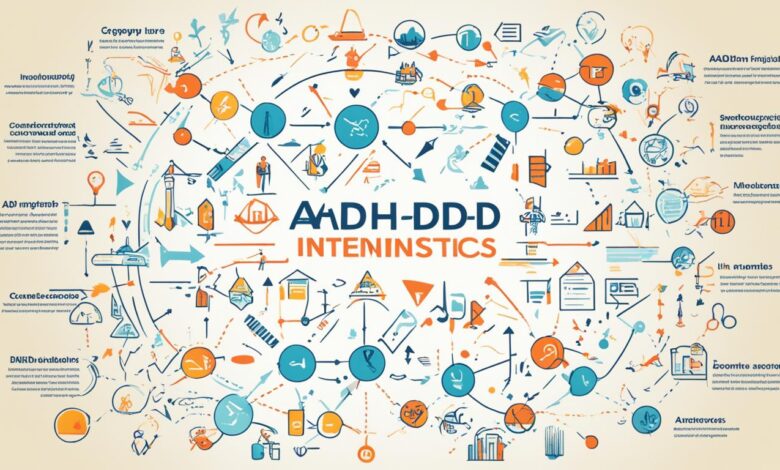Understanding Causes of Childhood ADHD

Every parent worries at the first signs of inattention or hyperactivity in their child, wondering: What Are the Causes of Childhood ADHD? Looking into the origins of childhood ADHD combines human stories with science.
Childhood ADHD doesn’t come from just one cause. It’s like a quilt made from different pieces—genes, brain science, and environment. Understanding these reasons shows us the challenges many families face. It also highlights the progress science has made in tackling this complex issue affecting so many lives.
The Neurobiological Factors of Childhood ADHD
We look into how ADHD in children factors are influenced by the brain’s workings. By understanding these aspects, we can better grasp the struggles of kids with ADHD. This helps guide the way to more specific treatments.
ADHD and the Brain’s Anatomy
Studying childhood ADHD means looking at the brain’s makeup and function. Researchers found that some brain parts don’t work as actively as they should. These areas are crucial for focusing and controlling actions. This low activity level is a clue to the unique brain functions of kids with ADHD.
Genealogy and Heredity Influences
Genetics play a big part in factors for childhood ADHD. There’s a genetic link, as ADHD often shows up in families. It’s common among brothers, sisters, and parents, showing how genetics influences ADHD.
The Impact of Brain Injuries on Pediatric ADHD
Major brain injuries are a big factor in kids developing ADHD. Injuries can mess with the brain’s network, affecting how a child thinks and learns. This shows the critical relationship between brain health and a kid’s mental development.
Looking into ADHD’s brain-based causes is key to finding good treatments. It’s important for helping kids and their families handle the disorder.
Environments and ADHD: Assessing Prenatal and Early Childhood Exposures
Childhood ADHD starts from a mix of environment and genes. It’s critical to understand childhood ADHD triggers to find the best solutions. Prenatal factors play a big role in ADHD, showing why expectant mothers must know their risks.
Risks Linked to Alcohol and Nicotine Use During Pregnancy
Maternal use of substances like alcohol and tobacco during pregnancy increases the chance of ADHD in children. These habits affect the brain’s development in key ways. This calls for policy changes to ensure healthier beginnings for babies.
Lead Exposure and Childhood ADHD Concerns
Lead exposure is a serious, though uncommon, risk for ADHD. Efforts are ongoing to reduce lead exposure in kids. Yet, even small amounts can be harmful, stressing the need for constant prevention work.
The Influence of Prematurity on ADHD Development
Improved neonatal care has saved many premature infants. However, these advances come with an increased ADHD risk. It adds a new challenge in taking care of and monitoring these infants’ development closely.
| Prenatal Factor | Impact on ADHD Risk |
|---|---|
| Alcohol Use | Increases the risk of ADHD in offspring |
| Nicotine Use | Associated with higher rates of ADHD symptoms |
| Lead Exposure | Linked to ADHD and cognitive deficits in children |
| Prematurity | Correlates with a greater incidence of ADHD diagnosis |
Knowing these childhood ADHD triggers is key to preventing them. Efforts to spread awareness can lower the impacts of these environmental factors. This could change the future of ADHD, leading to better health and development for all kids.
Behavioral Symptoms and Challenges in ADHD Diagnoses
Identifying childhood ADHD symptoms means looking closely at each child’s behavior. It’s important for those close to children to know the signs. This knowledge helps start the journey of diagnosing ADHD in children early.
Recognizing Hyperactive and Impulsive Behaviors in Kids
To spot hyperactivity and impulsivity, watch for actions not typical for their age. Kids might run around when they should sit still, or talk non-stop, pointing to hyperactivity. Impulsivity shows when they act hastily, interrupt, or ignore rules just to be first.
Identifying Inattentive Presentation Amongst Children
Looking at inattention in ADHD kids, there’s a clear struggle. These kids might daydream, miss details, and not follow instructions well. Their forgetfulness and messy habits aren’t occasional. They consistently affect school and friendships.
| Hyperactive Behaviors | Impulsive Behaviors | Inattentive Behaviors |
|---|---|---|
| Excessive fidgeting | Interrupting others | Poor focus on tasks |
| Inability to stay seated | Difficulty taking turns | Disorganization |
| Non-stop talking | Acting without thinking | Forgetfulness in daily activities |
| Restlessness | Impatience | Failure to follow through on instructions |
To help kids with ADHD, observing them in different places is key. Watching how they act at home and school helps. Combined with expert advice, this helps tailor the right support for each child.
Effective Treatment Paradigms for Childhood ADHD
Treatments for childhood ADHD mix therapy, medication, and lifestyle tweaks. This combo is crucial for managing symptoms and helping growth. It helps families and kids with ADHD succeed and stay hopeful. A well-rounded and custom approach is best, making sure all treatments work together well.
Behavior Therapy and Parent Training
Behavior therapy is a key first step for children with ADHD. Parent training is also vital. It teaches them how to support their child better. This includes improving communication, encouraging good behavior, and keeping routines. These help children control themselves better and pay attention longer.
Medication Options and Management
Medication is important in treating kids’ ADHD, with psychostimulants leading the way. They help kids focus and act less on impulse. Medication aims to balance brain chemicals, aiding in focus and behavior. Careful monitoring ensures the right medicine and dose, while watching for side effects.
Lifestyle Changes and Support for ADHD Children
Healthy living is crucial for kids with ADHD. A balanced diet, exercise, and sleep help their wellbeing. These habits boost other treatments, improving brain function and behavior. Support from everyone around them also matters. It creates a supportive setting that meets their unique needs.








